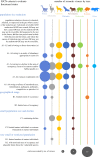Global shifts in mammalian population trends reveal key predictors of virus spillover risk
- PMID: 32259475
- PMCID: PMC7209068
- DOI: 10.1098/rspb.2019.2736
Global shifts in mammalian population trends reveal key predictors of virus spillover risk
Abstract
Emerging infectious diseases in humans are frequently caused by pathogens originating from animal hosts, and zoonotic disease outbreaks present a major challenge to global health. To investigate drivers of virus spillover, we evaluated the number of viruses mammalian species have shared with humans. We discovered that the number of zoonotic viruses detected in mammalian species scales positively with global species abundance, suggesting that virus transmission risk has been highest from animal species that have increased in abundance and even expanded their range by adapting to human-dominated landscapes. Domesticated species, primates and bats were identified as having more zoonotic viruses than other species. Among threatened wildlife species, those with population reductions owing to exploitation and loss of habitat shared more viruses with humans. Exploitation of wildlife through hunting and trade facilitates close contact between wildlife and humans, and our findings provide further evidence that exploitation, as well as anthropogenic activities that have caused losses in wildlife habitat quality, have increased opportunities for animal-human interactions and facilitated zoonotic disease transmission. Our study provides new evidence for assessing spillover risk from mammalian species and highlights convergent processes whereby the causes of wildlife population declines have facilitated the transmission of animal viruses to humans.
Keywords: exploitation; habitat loss; spillover; threatened species; virus; zoonotic disease.
Conflict of interest statement
The authors have no competing interests.
Figures



Similar articles
- Mammals, wildlife trade, and the next global pandemic.Curr Biol. 2021 Aug 23;31(16):3671-3677.e3. doi: 10.1016/j.cub.2021.06.006. Epub 2021 Jul 7.Curr Biol. 2021.PMID: 34237267
- Risk of Viral Infectious Diseases from Live Bats, Primates, Rodents and Carnivores for Sale in Indonesian Wildlife Markets.Viruses. 2022 Dec 10;14(12):2756. doi: 10.3390/v14122756.Viruses. 2022.PMID: 36560762Free PMC article.
- Synthesizing the connections between environmental disturbances and zoonotic spillover.An Acad Bras Cienc. 2022 Sep 19;94(suppl 3):e20211530. doi: 10.1590/0001-3765202220211530. eCollection 2022.An Acad Bras Cienc. 2022.PMID: 36169531Review.
- Host and viral traits predict zoonotic spillover from mammals.Nature. 2017 Jun 29;546(7660):646-650. doi: 10.1038/nature22975. Epub 2017 Jun 21.Nature. 2017.PMID: 28636590Free PMC article.
- Bats and emerging zoonoses: henipaviruses and SARS.Zoonoses Public Health. 2009 Aug;56(6-7):278-84. doi: 10.1111/j.1863-2378.2008.01218.x.Zoonoses Public Health. 2009.PMID: 19497090Review.
Cited by
- Dengue-2 and Guadeloupe Mosquito Virus RNA Detected in Aedes (Stegomyia) spp. Collected in a Vehicle Impound Yard in Santo André, SP, Brazil.Insects. 2021 Mar 16;12(3):248. doi: 10.3390/insects12030248.Insects. 2021.PMID: 33809477Free PMC article.
- The role of invasive alien species in the emergence and spread of zoonoses.Biol Invasions. 2023;25(4):1249-1264. doi: 10.1007/s10530-022-02978-1. Epub 2022 Dec 20.Biol Invasions. 2023.PMID: 36570096Free PMC article.
- SARS-CoV-2 and COVID-19: A genetic, epidemiological, and evolutionary perspective.Infect Genet Evol. 2020 Oct;84:104384. doi: 10.1016/j.meegid.2020.104384. Epub 2020 May 29.Infect Genet Evol. 2020.PMID: 32473976Free PMC article.Review.
- Integrating databases for spatial analysis of parasite-host associations and the novel Brazilian dataset.Sci Data. 2023 Nov 2;10(1):757. doi: 10.1038/s41597-023-02636-8.Sci Data. 2023.PMID: 37919263Free PMC article.
- Post COVID-19: a solution scan of options for preventing future zoonotic epidemics.Biol Rev Camb Philos Soc. 2021 Dec;96(6):2694-2715. doi: 10.1111/brv.12774. Epub 2021 Jul 7.Biol Rev Camb Philos Soc. 2021.PMID: 34231315Free PMC article.Review.

